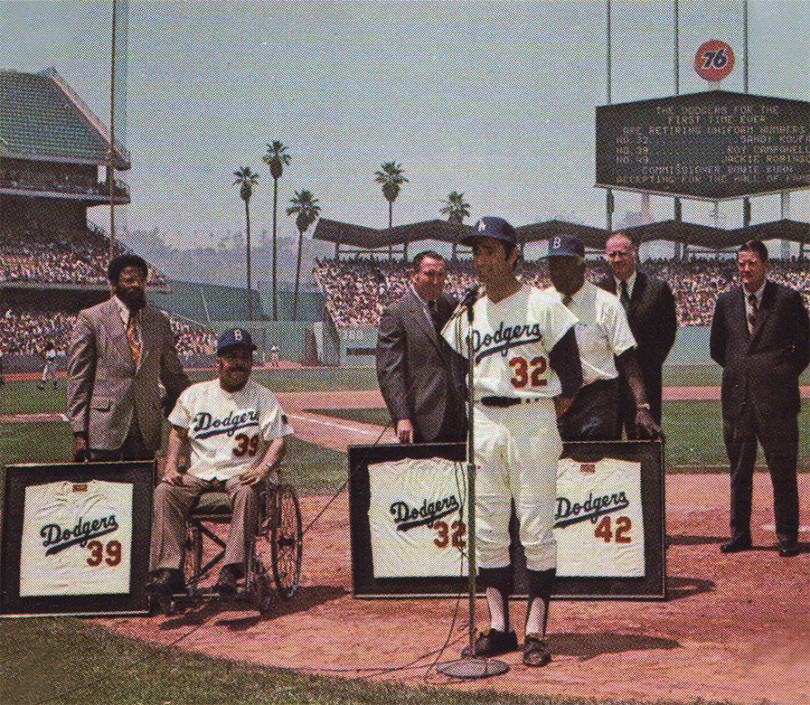
June 4, 1972, Sandy Koufax is at the microphone on the day three Dodger players have their uniform number retired, including Jackie Robinson (42); Roy Campanella (39); and Koufax (32). (L-R): Attendant for Roy Campanella; Campanella; Chub Feeney, National League President; Koufax; Robinson; Bowie Kuhn, Baseball Commissioner; and Peter O’Malley, Dodger President.
Moments of Los Angeles: Iconic Events at Dodger Stadium (1970-1990s)
By Brent Shyer
From the 1970s through the 1990s, when Dodger Stadium was not in use for Dodger baseball games, it was a showplace for unforgettable sporting, religious, and music events.
March 28, 1970 - Martin Luther King, Jr. East-West Major League Baseball Classic
Following the April 4, 1968 assassination of Dr. Martin Luther King, Jr., numerous major league players coalesced to take action to memorialize his legacy, and with that prevailing sentiment, the Southern Christian Leadership Conference (SCLC) approached then Baseball Commissioner William Eckert about an exhibition game. Originally, the concept was to play either in the fall of 1968 or in March, 1969 at Dodger Stadium, Los Angeles. Although Major League Baseball and the Dodgers were preparing to play the game then, the SCLC decided more time was needed for planning and SCLC leadership asked if the game could be delayed until the following spring.
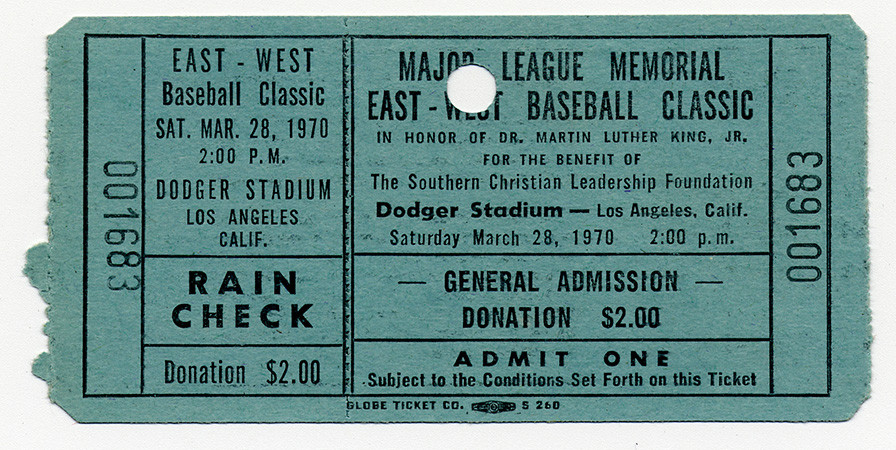
A $2.00 general admission ticket from the Martin Luther King, Jr. Major League Baseball Memorial East-West Baseball Classic held on March 28, 1970 at Dodger Stadium. Many major league players wanted to take action to memorialize Dr. King’s legacy and with that prevailing sentiment, the Southern Christian Leadership Conference (SCLC) approached then Baseball Commissioner William Eckert about an exhibition game. The SCLC decided to play the game in 1970 with the encouragement and support of Walter and Peter O’Malley.
Thus, the Martin Luther King, Jr. East-West Major League Baseball Classic, was established to honor the civil rights leader and was played Sunday, March 28, 1970 at Dodger Stadium, featuring top major league players. Two players from each of the 24 National and American League teams were selected. In fact, 23 current and future Hall of Fame players were in uniform at the one-time exhibition game. Tom Verducci, SI.com, January 18, 2021
Coretta Scott King threw the ceremonial first pitch. A portion of Dr. King’s “I Have A Dream” speech was played before the game. New Baseball Commissioner Bowie Kuhn and King’s successor Rev. Ralph Abernathy briefly spoke pregame to the crowd. Dodger Hall of Famer Roy Campanella was the manager of the West team and Joe DiMaggio was the manager of the East team. The game was played near the end of Spring Training and drew 31,694 fans for the exhibition. Dodger Hall of Famer and American icon Jackie Robinson and his wife Rachel were in attendance. In 1968, Dr. King said of Robinson, “Jackie Robinson made my success possible. Without him, I would never have been able to do what I did.” William C. Kashatus, Philadelphia Inquirer, January 18, 1997
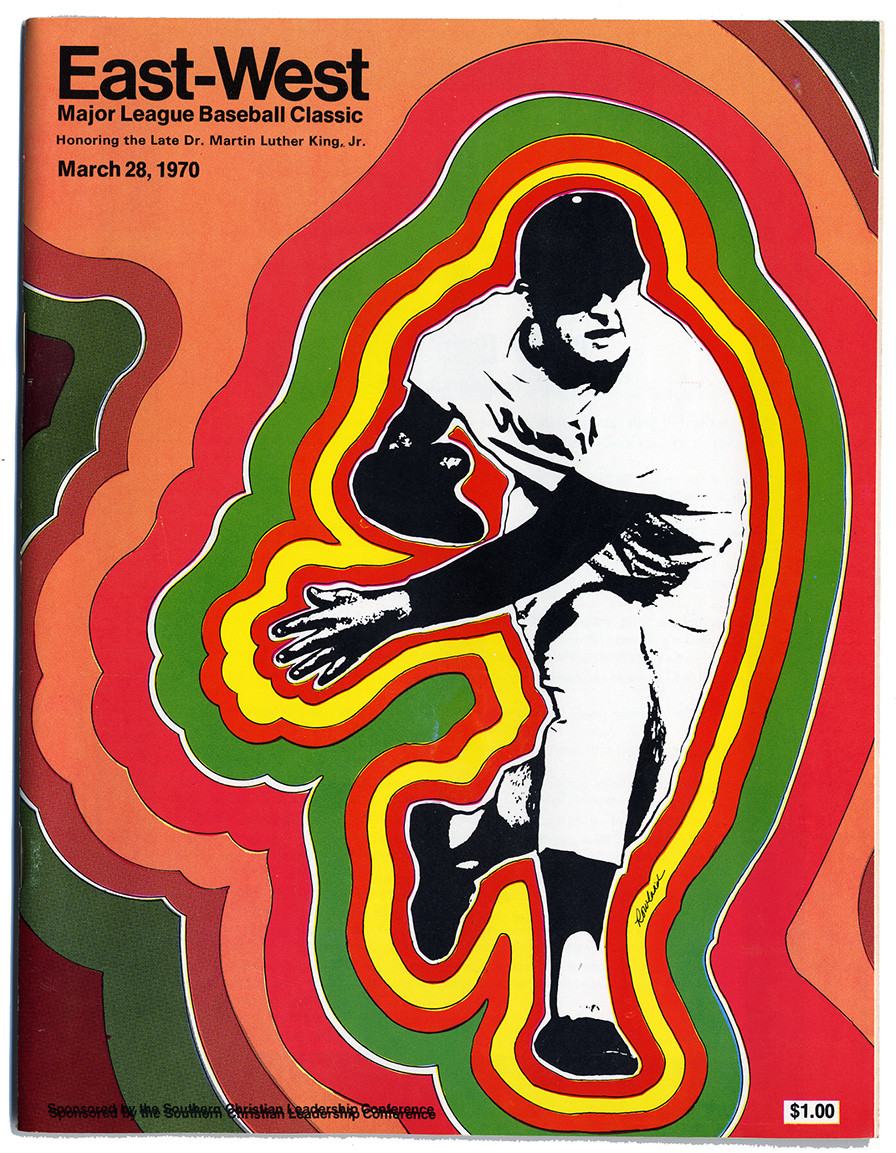
March 28, 1970 program cover from the Martin Luther King, Jr. Major League Baseball Memorial East-West Baseball Classic at Dodger Stadium. Attending the game were Coretta Scott King and Jackie Robinson and his wife Rachel. Hall of Fame Dodger catcher Roy Campanella was manager of the West team. On January 18, 2021, Sports Illustrated called the exhibition “The Greatest (Forgotten) Game Ever Played”, as 23 current and former Baseball Hall of Famers were in uniform including Joe DiMaggio, who managed the East team.
Coaches included for the East: Billy Martin, Satchel Paige, Stan Musial and John McNamara. Coaches for the West: Sandy Koufax, Don Drysdale, Don Newcombe and Elston Howard. Players flew to Los Angeles from around the country and even as far away as Japan (as did Willie Mays whose San Francisco Giants were playing exhibition games) for the day to honor Dr. King. Michael A. Fletcher, theundefeated.com, January 15, 2018 Former Dodger pitcher Jim “Mudcat” Grant sang the national anthem in a white suit, before changing into his Oakland A’s uniform. The first Black umpire in the majors, Emmett Ashford, worked behind the plate. The East team beat the West team, 5-1. Ron Fairly of the Montreal Expos was named game MVP as he hit a home run for the East.
The game featured a Black manager in Campanella; a Black starting pitcher from the Houston Astros in Don Wilson; and the only Black umpire in Major League Baseball in Ashford. The Los Angeles Times story stated, “A few years ago, it couldn’t have happened.” Dwight Chapin, Los Angeles Times, March 29, 1970
Dodger Chairman of the Board Walter O’Malley and Dodger President Peter O’Malley were instrumental in offering support from staff and hosting of the game at Dodger Stadium, keeping travel expenses to a minimum as the SCLC was the beneficiary of the net proceeds of $30,000 to help construct the Martin Luther King, Jr. Center in Atlanta, Georgia.
On January 18, 2021, Sports Illustrated’s website called it “The Greatest (Forgotten) Game Ever Played: MLB’s 1970 Exhibition Game to Honor MLK”.
June 4, 1972 - Uniform Number Retirement for Jackie Robinson,
Roy Campanella and Sandy Koufax
On June 4, 1972, Dodger greats Jackie Robinson (42), Roy Campanella (39) and Sandy Koufax (32) all had their uniform numbers retired in on-field pregame ceremonies at Oldtimers Day. Robinson and Campanella had been inducted into the National Baseball Hall of Fame (in 1962 and 1969, respectively) and Koufax was to receive the honor on August 7, 1972. Robinson told the crowd, “This is truly one of the greatest moments of my life.” In a letter to Peter O’Malley four days later, Robinson wrote, “I want you to know that I was never so moved by the response of the fans as on that day. Without doubt, you must be aware that I considered the Brooklyn Dodgers’ fans as the greatest ever, but the warmth and enthusiasm that was demonstrated at the Oldtimers’ Game made me realize what great fans you have in the Los Angeles area.” Hall of Fame induction was the standard by which the Dodgers retired uniform numbers. The only exception was longtime beloved Dodger player and Coach Jim Gilliam who passed away two days before the start of the 1978 World Series at Dodger Stadium and was so honored.
I want you to know that I was never so moved by the response of the fans as on that day…
American icon and Hall of Fame Dodger Jackie Robinson
Memorable 1975 Elton John concerts and more through the 1990s
On October 25 and 26, 1975, Elton John played to two sold-out concerts (more than 110,000 adoring fans) at Dodger Stadium. At the time, it set a record for the largest crowds by a solo artist. He performed wearing a stunning Bob Mackie-designed Dodger sequined uniform. That was the first concert held at Dodger Stadium since the Beatles played their next-to-last live public concert on August 28, 1966. Dodger President Peter O’Malley said of the concerts at Dodger Stadium, “Elton John is a very special act. He also attracts a very special audience. I doubt if we’re going to find many who can match his standards. When someone else comes along like the Beatles or Elton John, we might do it again. But, we want to hold it at that level. Dodger Stadium was built for baseball.” Robert Hilburn, Los Angeles Times, October 28, 1975
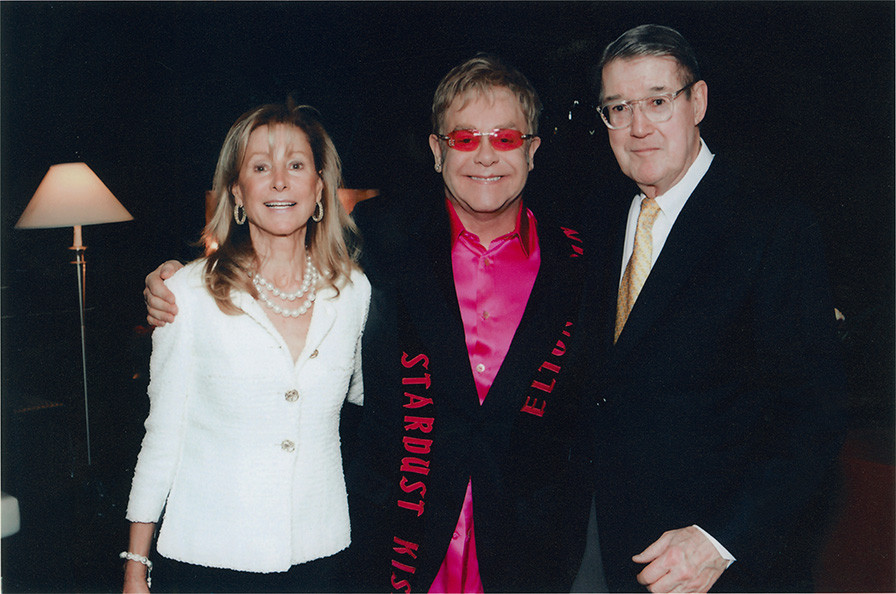
May 6, 2010, Elton John concert at the Wiltern Theatre in Los Angeles. (L-R): Annette O’Malley (Mrs. Peter); Sir Elton John; and Peter O’Malley. Singer-composer-pianist John’s two sold-out concerts at Dodger Stadium on October 25 and 26, 1975 at the time set records for the largest crowds by a solo artist.
In the Los Angeles Times, music critic Robert Hilburn wrote, “John’s Saturday and Sunday appearances were indeed akin to a World Series for rock music fans. Not only is singer-composer-pianist John the biggest star in pop music, but his weekend concerts marked the first time a rock act had played Dodger Stadium – the city’s most prestigious and best-designed outdoor facility – since the Beatles in 1966. The audience response, predictably, was tumultuous at times. In fact, the 55,000 fans Saturday reacted to the key moments of John’s show with the kind of enthusiastic abandon that O’Malley and his staff probably thought was limited to a series-winning, bottom-of-the-ninth Steve Garvey double.
“There were mini-ovations through John’s more-than-3 1/2-hour set Saturday, but the emotional high point came during the encore when John, obviously touched by the audience response, brought lyricist Bernie Taupin and John’s tennis champion pal Billie Jean King on stage to sing backup vocals during raucous, extended versions of ‘Saturday Night’s Alright for Fighting’ and ‘Pinball Wizard.’” Robert Hilburn, Los Angeles Times, October 27, 1975
The next major concert was held on July 7, 1979 as the Bee Gees performed to a sold out crowd of 56,000. On August 27, 1983, Simon & Garfunkel held a concert as part of their national tour. In 1984, the Jackson’s “Victory Tour,” with “King of Pop” Michael Jackson, made its worldwide stop at Dodger Stadium for two weekends, November 30-December 2 and December 7-9. Over the course of the 1980s and 1990s, Dodger Stadium was the site of numerous concerts, ranging from Genesis, the Cure, David Bowie, Lenny Kravitz, and Depeche Mode to Eric Clapton/Elton John, U2, KISS, and The Rolling Stones.
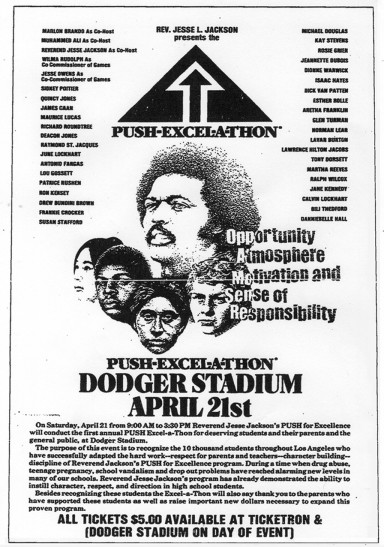
Reverend Jesse Jackson presented the PUSH-Excel-A-Thon at Dodger Stadium to recognize 10,000 students throughout the greater Los Angeles area who successfully adapted the hard work – respect for parents and teachers – character building – discipline of his People United to Save Humanity (PUSH) for Excellence program. This is an ad showing Jackson in the center for the special event, which was attended by many celebrities and athletes on April 21, 1979.
April 21, 1979 - PUSH-EXCEL-A-Thon Presented by Rev. Jesse L. Jackson
On April 21, 1979, Dodger Stadium was donated for the day and the site of PUSH-Excel-A-Thon, presented by Rev. Jesse L. Jackson. According to an ad for the event, “the purpose of this event is to recognize 10,000 students throughout Los Angeles who have successfully adapted the hard work – respect for parents and teachers – character building – discipline of Reverend Jackson’s PUSH (People United to Save Humanity) for Excellence program. During a time when drug abuse, teenage pregnancy, school vandalism and drop out problems have reached alarming new levels in many of our schools, Reverend Jackson’s program has already demonstrated the ability to instill character, respect, and direction in high school students.” Some 15,000 were at the one-time event for students, their parents and the general public. Co-chairing the occasion were California Governor Edmund G. Brown Jr.; California Lieutenant Governor Mike Curb; Los Angeles Mayor Tom Bradley; Dodger President Peter O’Malley; and Partner, Ernst & Ernst Walter Beran. Awards were presented to students who participated in on field games and competitions including races, soccer, and tug-of-war. Olympic champions Jesse Owens and Wyomia Tyus were co-commissioners of the games. Speakers included Gov. Brown, as well as actor Marlon Brando. Many actors participated including Sidney Poitier, George Peppard, Lou Gossett Jr., Michael Douglas, LeVar Burton, Penny Marshall and Rob Reiner, as well as funk & soul band the Commodores, and “Queen of Soul” singer Aretha Franklin. The CBS-TV show “60 Minutes” recorded the proceedings. John M. Wilson, Los Angeles Times, May 27, 1979
July 8, 1980 - 51st Major League Baseball All-Star Game
The Dodgers hosted the 51st Major League Baseball All-Star Game on July 8, 1980. The National League defeated the American League, 4-2, before 56,088 fans at Dodger Stadium. Dodger left-handed pitcher Jerry Reuss was the winning pitcher, while Cincinnati’s Ken Griffey, Sr. was the game’s MVP after hitting a home run.
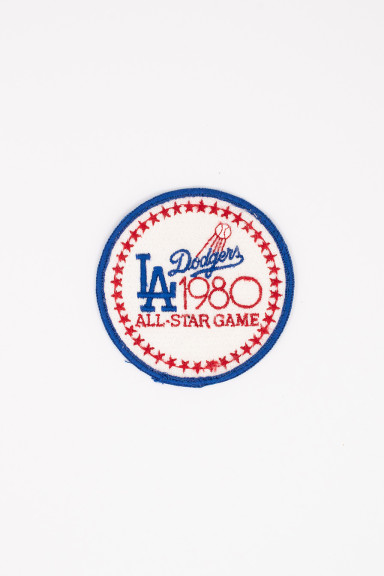
A special patch was created for the 1980 Major League Baseball All-Star Game played at Dodger Stadium, July 8, 1980. The design incorporates 51 stars representing the 51st All-Star Game played. The “LA” logo and the “Dodgers” logo are contained in the patch. It was the first MLB All-Star Game played in L.A. since 1959 at the Memorial Coliseum.
The 1980 game marked the debut of Mitsubishi Electric Company’s Diamond Vision at Dodger Stadium, the world’s first full-color large screen video board, an innovation that set the standard and led to new highs for in-game entertainment and fan enjoyment. Mitsubishi’s new technology featured high-response cathode-ray tubes (each produced only one color – red/green/blue in groups of three) making the thousands of tubes resolution brilliant, with TV quality images and true color fidelity, despite the 20’ high x 28’ wide screen. The Nagasaki, Japan-based firm sped up its production when Dodger President Peter O’Malley ordered it in February, 1980. He and a handful of Dodger executives traveled to Nagasaki to view a 1/30th scale model demonstration of the technology and were immediately convinced that it would be a game-changer and to have it ready to debut at the All-Star Game.
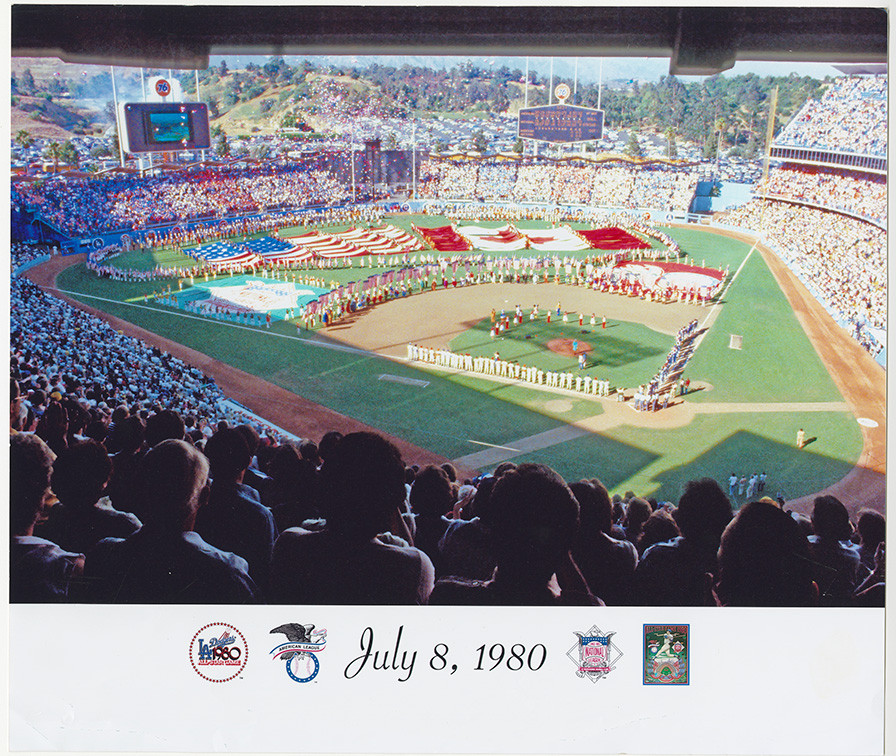
July 8, 1980, the 51st All-Star Game is played at Dodger Stadium. Grammy award-winning singer Toni Tennille, in a blue dress on the pitching mound, sang the national anthem. The game featured the world’s first state-of-the-art color video screen with the debut of Dodger Diamond Vision (by Mitsubishi Electric Corp.), which would significantly impact all sports in-stadium entertainment.
July 31-August 7, 1984 - Eight-Team Exhibition Tournament of the Games of the XXIII Olympiad
From July 31-August 7, 1984, Dodger Stadium was home to the most extensive involvement in Olympic Baseball history at the time, an eight-team exhibition tournament as part of the Games of the XXIII Olympiad in Los Angeles. Since 1904, Olympic Baseball had been played as an exhibition game but nothing as elaborate as 16 games in eight days. Baseball was selected as one of two demonstration sports (tennis the other) during the Olympic Games with a goal of getting gold medal status in future games. The eight nations participating included Canada, Chinese Taipei, Dominican Republic, Italy, Japan, Nicaragua, South Korea, and the United States.
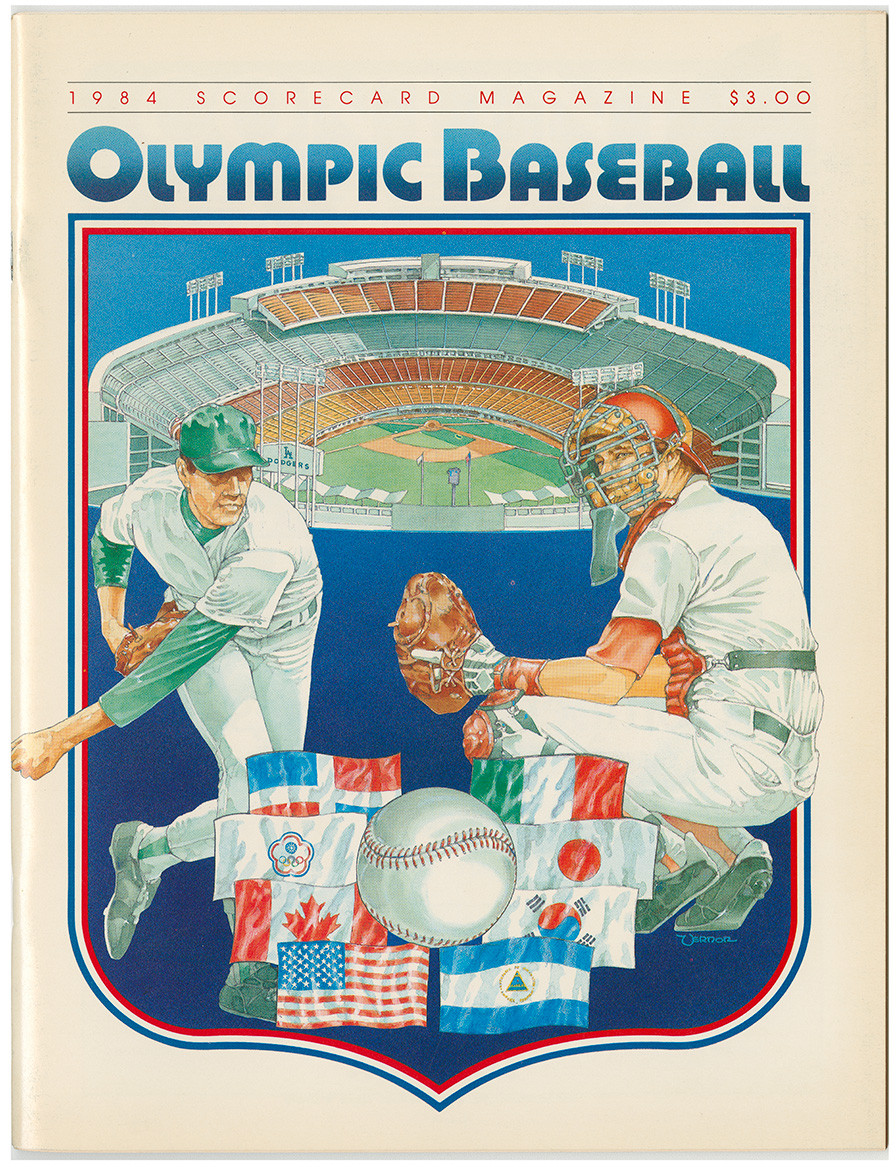
The cover of the baseball program for eight-team 1984 exhibition tournament at Dodger Stadium during the Games of the XXIII Olympiad. The cover shows artwork of Dodger Stadium and the eight flags representing the countries that played in the historic event.
The excitement of the tournament at Dodger Stadium and the artistic and financial success derived therefrom led International Olympic Committee President Juan Antonio Samaranch to state at the closing press conference for the 1984 Los Angeles Games, “I now think that baseball should be added to the Olympic Games.”
The competition was fierce and appreciated by sold out crowds at Dodger Stadium. Japan won the final game against the USA, 6-3, before 55,235 fans. Baseball’s overall attendance ranked third in the Games of the XXIII Olympiad, ranking behind only track & field and soccer.
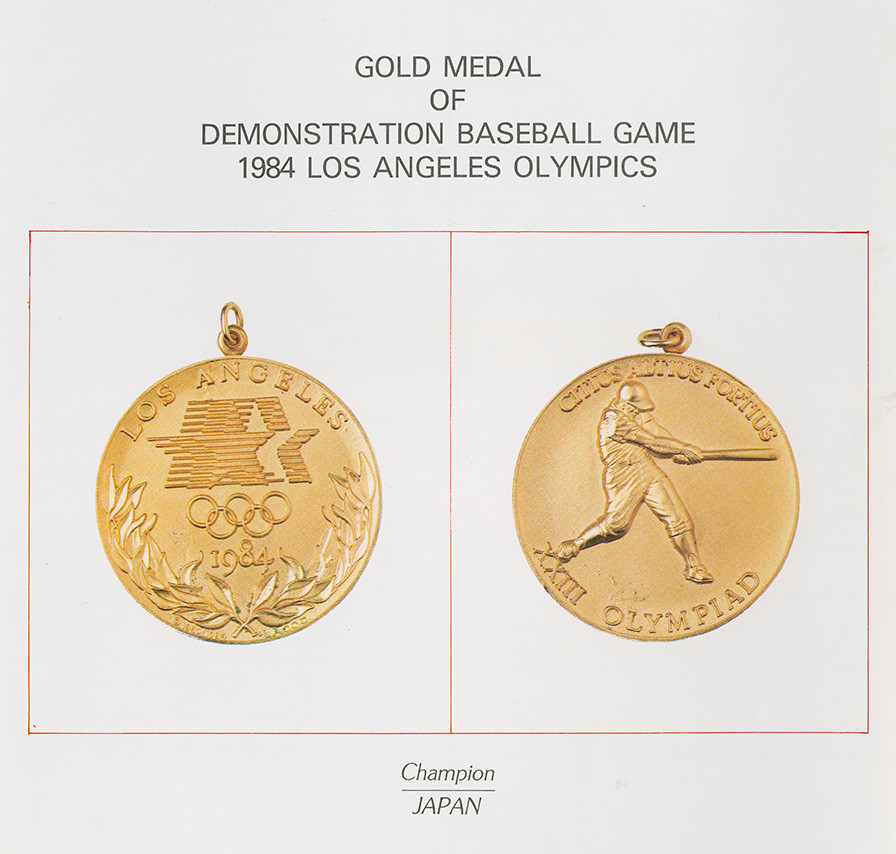
August, 1984, photo of the gold medal received by team Japan when they won the eight-team Olympic baseball exhibition tournament at Dodger Stadium during the Games of the XXIII Olympiad in Los Angeles. On August 7, Japan defeated the USA, 6-3, before a sellout crowd of 55,235, in the final game.
For many years, International Baseball Association President Dr. Bob Smith, Baseball Commissioner Bowie Kuhn, Dodger President Peter O’Malley and legendary University of Southern California Head Baseball Coach Rod Dedeaux worked in concert advocating the permanent inclusion of baseball in the Olympic Games. With the Dodgers guaranteeing the financial success of the exhibition baseball tournament at Dodger Stadium, it created the momentum needed to continue pursuing that goal. On October 13, 1986 in Lausanne, Switzerland, baseball received the good news that it had been hoping for as the IOC voted to approve the sport on the official Olympic Games program beginning in 1992. Global baseball leaders always felt the success of the 1984 tournament and its great international appeal was a watershed moment in the quest for inclusion.
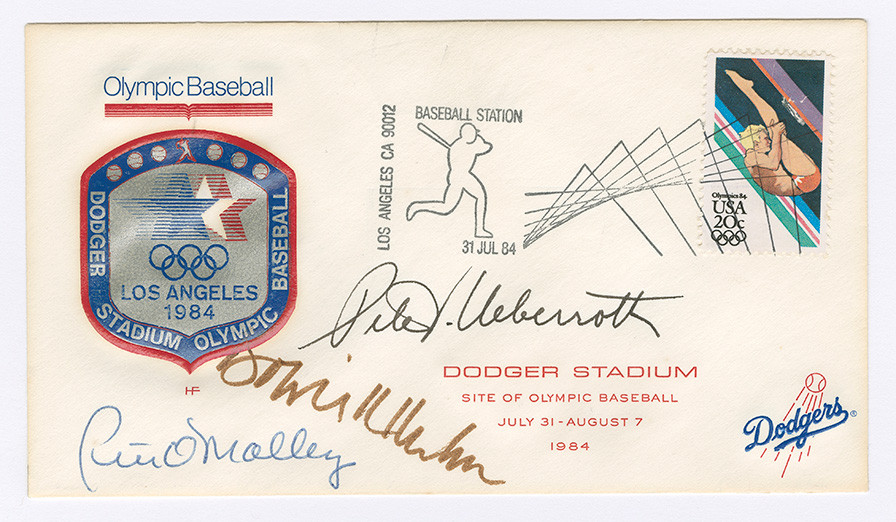
The first day cover envelope for the baseball exhibition tournament (July 31, 1984) during the Games of the XXIII Olympiad in Los Angeles. The cover is signed by Peter Ueberroth, President, Los Angeles Olympic Organizing Committee; Bowie Kuhn, Baseball Commissioner; and Peter O’Malley, who advocated international support for baseball as an Olympic gold medal sport and hosted the tournament at Dodger Stadium. Ueberroth succeeded Kuhn as Baseball Commissioner in 1984.
September 16, 1987 - Mass with Pope John Paul II
On Wednesday, September 16, 1987, Pope John Paul II celebrated a Mass at Dodger Stadium before the largest crowd in Dodger Stadium history at 63,000. Cathleen Decker, Los Angeles Times, “The Papal Visit,” September 17, 1987 The previous Dodger Stadium baseball attendance record was 56,242 for the Dodgers vs. New York Yankees in the 1981 World Series. According to the Los Angeles Times report, “…the overriding emotion of the night was not deference but joy. Before the Pope’s arrival, a few white-robed priests seated near the altar lurched upward in a trendy, if ultimately unsuccessful, attempt at ‘the wave.’ Ethnic dance and singing groups took the stage, prompting ever-increasing rounds of applause from the audience. A gospel trio stood and sang ‘He’s Got the Whole World in His Hands’ and the crowd spontaneously shouted and clapped its approval. A sky writer sprayed the image of a cross overhead. And the Pope, when he saw it, grinned.” Ibid.
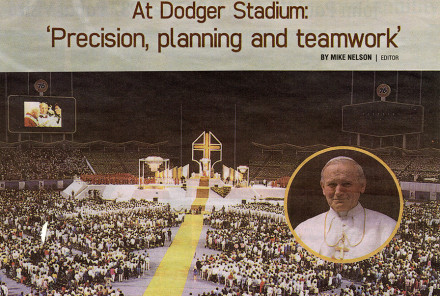
Headline in The Tidings and a photograph of Pope John Paul II celebrating a Mass at Dodger Stadium on September 16, 1987. A crowd of 63,000 was the largest in Dodger Stadium history.
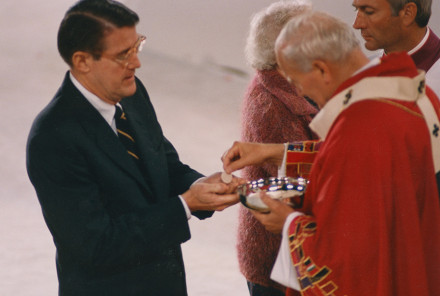
September 16, 1987, His Holiness Pope John Paul II celebrates Mass at Dodger Stadium. Peter O’Malley receives Holy Communion from Pope John Paul II.
The Pope addressed the crowd from an elaborate 14,000-square foot stage erected in center field that was part of 500,000 pounds of production gear used for the set-up during the one-time event. Paul Feldman, Los Angeles Times, “Dodger Crew Has Frantic Field Day Over Papal Mass,” September 17, 1987 The set-up began right after the Tuesday, September 15 Dodgers-Houston game finished around 10 p.m. and went non-stop until the afternoon of the Mass on Wednesday. The tear-down was just as critical timing-wise as the Dodgers were right back to their home schedule with a 4:05 p.m. doubleheader against Cincinnati on Thursday, September 17. A large contingent of Catholic high school students volunteered to carry out some 10,000 folding chairs from the Dodger Stadium playing field.
1991 - United States Olympic Festival and Second Annual International Baseball Association All-Star Game
In 1991, two significant events took place at Dodger Stadium. First, the United States Olympic Festival was held in Los Angeles and Dodger Stadium was the site for Opening Ceremonies. The two-hour spectacle with colorful pageantry was held on July 12 and televised live in L.A. on KTTV Fox Channel 11. Radio City Music Hall Productions managed the star-studded Opening Ceremonies with entertainers and top athletes participating. More than 4,200 athletes, coaches and trainers were in town for the Festival’s 10 days of competition in 37 sports.
On August 24, 1991, the second annual International Baseball Association All-Star Game was played at Dodger Stadium in cooperation with the Los Angeles Sports Council. Dodger Stadium was provided without fee as the game was dedicated to the memory of American hero and Hall of Fame Dodger Jackie Robinson. The top 22 amateur players from the Americas represented the West team, while 22 players from the other continents comprised the East. In all, participants from 28 countries were showcased. Dodger Hall of Fame catcher Roy Campanella and his teammate pitcher Don Newcombe were honorary coaches for the West, while Japan Baseball Hall of Fame slugger Sadaharu Oh was honorary coach for the East. Rachel Robinson, widow of Jackie, addressed the crowd prior to the game and threw the ceremonial first pitch. The West team won 8-7, led by Cuba’s Orestes Kindelan who homered, tripled, and drove in four runs.
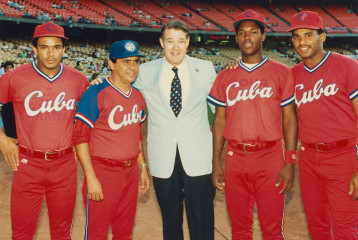
August 24, 1991, Dodger Stadium, Dodger President Peter O’Malley (center) with members of the Cuban National Baseball Team, including (L-R) Antonio Pacheco, 2nd baseman; Head Coach Sergio Borges Suarez; Omar Linares, 3rd baseman; and Orestes Kindelan, catcher/outfielder. O’Malley hosted the 2nd Annual International Baseball Association All-Star Game at Dodger Stadium featuring the finest amateur baseball stars – 44 players representing 28 countries – from around the world.
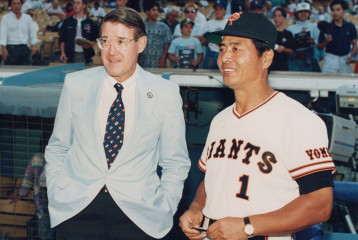
August 24, 1991, Dodger President Peter O’Malley visits with friend Sadaharu Oh, the all-time home run king of the Tokyo Yomiuri Giants. Oh was the honorary coach of the East team for the IBA All-Star Game at Dodger Stadium.
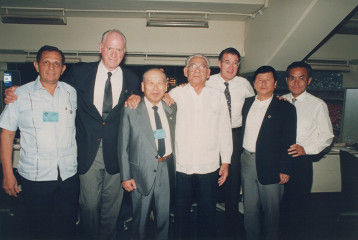
August 24, 1991 at the IBA World All-Star Game, a distinguished group of baseball leaders from around the world gather in the press box at Dodger Stadium. (L-R): Carlos Garcia, Minister of Sports, Nicaragua; Bowie Kuhn, Major League Baseball Commissioner (1969-1984); Jong Nak Kim, President, Korea Baseball Association and President, Baseball Federation of Asia; Manuel Gonzalez Guerra, longtime President, Cuba Baseball Federation, IBA Honorary President and IOC member; Peter O’Malley, Dodger President; Cai Jizhou, Vice President, All China Sports Federation; and Akihiro “Ike” Ikuhara, Assistant to Dodger President Peter O’Malley.
July 16, 1994 - “Encore: The Three Tenors” concert with Luciano Pavarotti, Plácido Domingo, and José Carreras, conducted by Zubin Mehta with the Los Angeles Philharmonic Orchestra
On July 16, 1994, perhaps one of the most intriguing and star-studded events in the history of Dodger Stadium was “Encore: The Three Tenors” concert with Luciano Pavarotti, Plácido Domingo, and José Carreras, conducted by Zubin Mehta with the Los Angeles Philharmonic Orchestra. The opera concert was held on the eve of the 1994 World Cup finals soccer game between Italy and Brazil at the Rose Bowl in Pasadena. Dodger Stadium was elegantly transformed into an intimate “concert hall.” TV stations in more than 100 countries carried the concert to adoring fans of the opera stars, representing the largest TV audience ever (1.3 billion) for a musical performance. In the United States, 18 million people watched on PBS that weekend. The sold out Dodger Stadium audience of 53,000 was filled with legendary entertainers, Frank Sinatra, Bob Hope, Gene Kelly, Charlton Heston, Sidney Poitier, Gregory Peck, and Dustin Hoffman among them. Former U.S. President George H.W. Bush and former First Lady Barbara Bush were in attendance, along with former U.S. Secretary of State Henry Kissinger.
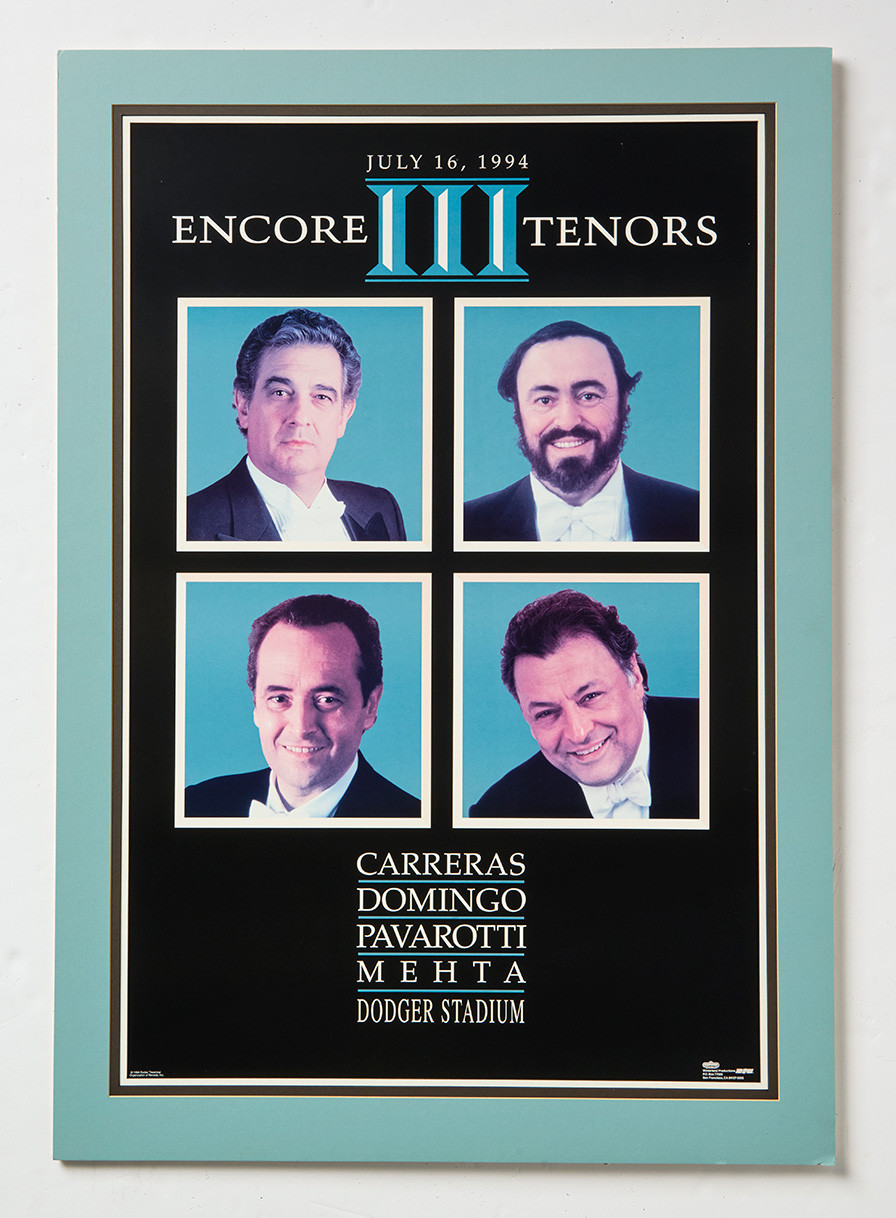
One of the most significant entertainment events in Los Angeles history took place at Dodger Stadium on July 16, 1994. “Encore: The Three Tenors” concert with Luciano Pavarotti, Placido Domingo, and Jose Carreras, and conducted by world renowned Zubin Mehta leading the Los Angeles Philharmonic Orchestra delighted a sellout crowd as well as an international television audience. This is a poster from the concert featuring The Three Tenors and Maestro Mehta.
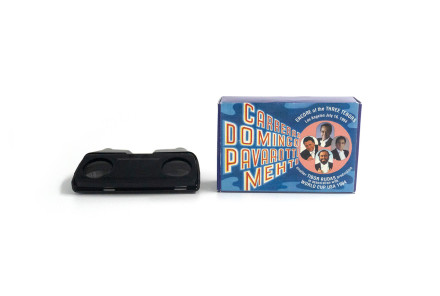
As each guest arrived at “Encore: The Three Tenors” concert at Dodger Stadium on July 16, 1994, they were presented with a pair of binoculars in a small box which showed photos of Luciano Pavarotti, Placido Domingo, Jose Carreras and conductor Zubin Mehta.
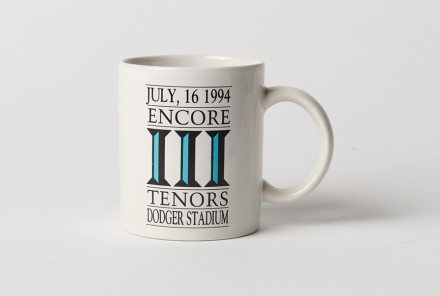
Coffee mugs were created for the July 16, 1994 “Encore: The Three Tenors” concert at Dodger Stadium.
The Los Angeles Times reported: “The Dodger Stadium audience, it must be noted, responded with energy of its own. The throng of incipient aficionados, estimated at 53,000, roared its unison approval at every Luftpause, and often between Luftpausen.” Martin Bernheimer, Los Angeles Times, “Greatest Tenor Show on Earth,” July 18, 1994
The concept started when Dodger President Peter O’Malley met with impresario Tibor Rudas. Discussions continued and O’Malley, with his longtime interest in music and the arts, was extremely enthusiastic about having Rudas present the concert to the world from Dodger Stadium. During the process, O’Malley and Rudas became good friends. O’Malley said after the concert, “A magical night, truly magical.” Mike Downey, ESPN.com, “Postcards of Dodger Stadium’s past,” April 5, 2012
Annual Jehovah’s Witness Assemblies
For decades, beginning in the 1960s, Dodger Stadium was the site for annual Jehovah’s Witness assemblies that filled the stadium with adherents listening to speakers and music under brightly colored parasols. Temporary pools were set up for large-scale baptisms.
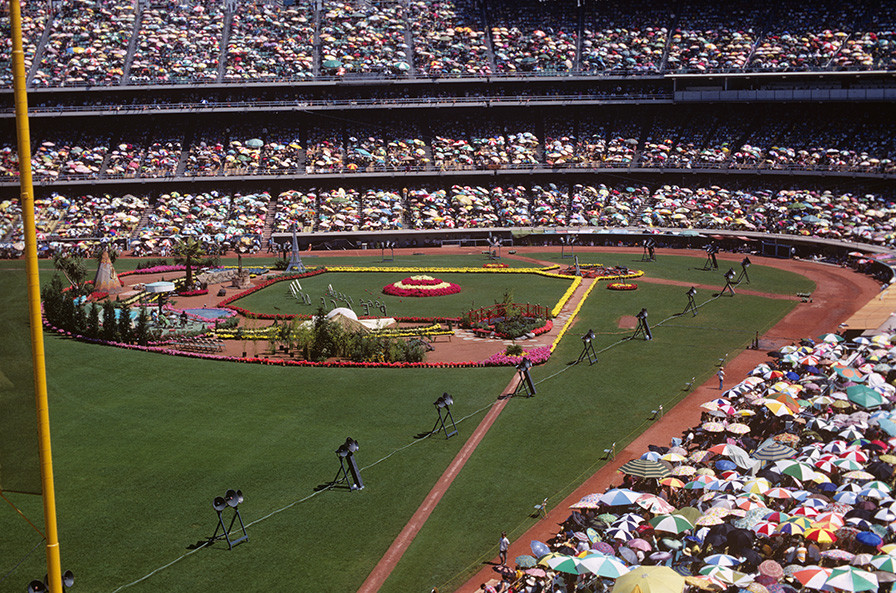
Jehovah’s Witness Assembly at Dodger Stadium in the 1970s. During long Dodger road trips in the summer, the Jehovah’s Witnesses gathered at Dodger Stadium for several days and brought colorful parasols to provide shade in the hot afternoons.
CIF and City Section Baseball Championships
The Dodgers began making Dodger Stadium available for the CIF and City Section Baseball Championships on June 4, 1969. The tradition has continued through the decades, one that has provided memories for a lifetime. Los Angeles City Section baseball teams and their fans experience the beauty and majesty of Dodger Stadium for the most important games of the high school season.

